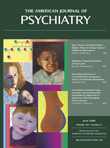Neuroimaging of Inhibitory Control Areas in Children With Attention Deficit Hyperactivity Disorder Who Were Treatment Naive or in Long-Term Treatment
Abstract
Objective: Difficulty with response inhibition is a cardinal symptom of attention deficit hyperactivity disorder (ADHD), combined type. Prefrontal and cingulate brain regions are known to be involved in inhibitory control. Event-related functional magnetic resonance imaging (fMRI) might establish if these regions differ in their activity in ADHD children relative to healthy comparison subjects. Method: Fifteen healthy comparison subjects and 17 children with ADHD, combined type, completed fMRI studies while performing the Stop Signal Task. Eight ADHD subjects were treatment naive; the remainder had a history of long-term treatment with stimulants, but they were medication free at the time of the fMRI. No subject had a learning disorder or a comorbid psychiatric condition (other than oppositional defiant disorder in the ADHD subjects). Results: Both the ADHD and comparison subjects activated the right dorsolateral prefrontal cortex on “stop” trials relative to “go” trials; this increase was greater in ADHD subjects. When inhibition was unsuccessful (relative to successful inhibition), healthy comparison subjects strongly activated the anterior cingulate cortex and the left ventrolateral prefrontal cortex. In contrast, the ADHD subjects did not show these differences. Activations in treatment-naive and ADHD subjects treated in the long term did not differ significantly in any brain regions. Conclusions: In relation to comparison subjects, ADHD subjects failed to activate the anterior cingulate cortex and the left ventrolateral prefrontal cortex after unsuccessful inhibition. These findings appear in treatment-naive ADHD individuals and are unlikely to be an artifact of long-term treatment with stimulants or of abrupt termination of stimulants before imaging.



